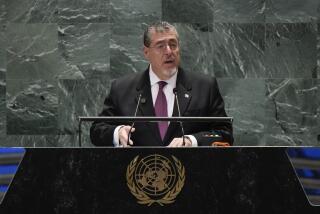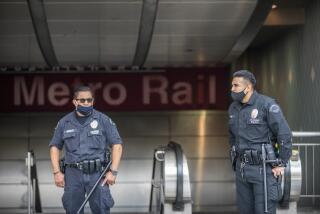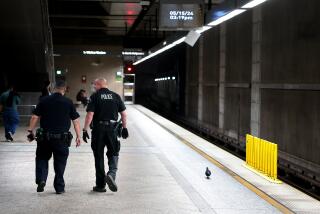U.S. seeks a larger village police force in Afghanistan
- Share via
Reporting from Washington — U.S. commanders seeking to increase security in remote parts of Afghanistan are planning to arm and train at least 20,000 Afghans to serve as village police, a doubling of the force announced last summer, according to U.S. and NATO officials.
Shortly after Gen. David H. Petraeus took command in Afghanistan in July, he persuaded Afghan President Hamid Karzai and his Cabinet to support the creation of 20- to 30-member police units in areas where few North Atlantic Treaty Organization and Afghan forces are present, the officials said.
Karzai’s advisors initially feared losing central control by creating yet another armed force alongside the existing army and police in a nation historically riven by tribalism and warlords.
Now officials within the International Security Assistance Force — the multinational military command in Kabul that Petraeus heads — believe the informal target of 20,000 could be revised upward if recruiting proves strong.
“I think it’s going to be more,” said a senior ISAF officer who is involved in the discussions said.
“Petraeus wants this to happen,” a civilian official said. “He would love to see 50,000.”
The officials agreed to speak about the plan on condition of anonymity because of the sensitivity of the deliberations.
When the program, known as Afghan Local Police, was announced in July, the Pentagon said it would be capped at 10,000 officers to keep it manageable while testing its effectiveness. Though that remains the official target, U.S. military officers say Petraeus favors a much larger effort, part of a broad push to improve security before next July, the deadline President Obama has set for beginning a drawdown of U.S. forces.
The Afghan army now has more than 134,000 troops; the national police has more than 109,000 officers. The national police in particular remains plagued by poor training, corruption and drug use — problems that are likely to afflict the new local police to some degree. Officials say those problems should be dealt with through trainer “mentoring.”
But building a new force of 20,000 could be difficult, several officials said.
Petraeus said recently that 68 locations for the police units already had been identified, and that about eight to 10 would be added each month. At that rate, it would take months to build a force of 10,000 members, much less reach the higher target.
Some of the locations are in eastern and central Afghanistan, including Wardak province, where a pilot program has been underway since last year. Other units are expected to be created in the south, where the insurgency is strongest and the village forces could face fierce fighting. It’s still unclear how eager Afghans would be to sign up in large numbers in these regions.
Some Afghan officials, meanwhile, have grown more enthusiastic in recent months about enlarging the program, the U.S. and ISAF officials said, noting that the Interior Ministry had recently proposed 40 more locations for the units.
The Pentagon already has requested authority from Congress to divert $35 million from elsewhere in the budget for Afghanistan operations to pay for the program, the officials said.
The effort is similar in some respects to the militia force that Petraeus helped nurture while he was in command in Iraq in 2007. At its peak, there were more than 100,000 members of the Sons of Iraq, or Awakening movement, as the local security forces were called; and these militias were credited with helping to reduce skyrocketing violence during the worst years of the insurgency there.
But that program ran afoul of Iraq’s Sunni-Shiite sectarian divide. The government has been reluctant to offer promised positions in the security forces to many Awakening members, and there are fears that some could return to the insurgency.
In Afghanistan, a country with a long history of warlordism and corruption, some officials and outside analysts contend that it is risky to create armed groups in areas often more controlled by local tribal leaders than by officials in Kabul. The danger could grow if the fledgling local police program is enlarged, they say.
Each of the Afghan Local Police units would receive several weeks of training, would be armed with AK-47 rifles and would have authority to arrest suspected insurgents and turn them over to the Afghan army or the national police.
“They are essentially community watches, with AK-47s,” Petraeus was quoted recently as saying in an interview with American Forces Press Service, an arm of the Pentagon’s public affairs operation.
The United States has promised to assign special forces mentors to each unit, along with Afghan Interior Ministry personnel, to ensure that the new units do not evolve into independent militias that prey on the people they are charged with protecting.
The U.S. has pledged to Karzai that he could eventually disband the local units or incorporate them into the national police. The U.S. also agreed that the units would be paid through the Interior Ministry.
“This is a completely government-run program with direct supervision by the [Interior Ministry] … along with the [U.S. special forces] teams,” a senior U.S. officer said.
As the number of local police members grows, at some point it will no longer be possible to assign a U.S. special forces team to mentor each unit, officials concede. So the ISAF is examining whether it might be possible to draw personnel from conventional U.S. and NATO units, as well as from the Afghan special forces, to serve as training advisors.
In theory, officials said, the impetus for creating these units is supposed to come from the communities themselves, with local tribal leaders offering men to serve as police to keep insurgents out of their villages.
But in reality, one official said, these units will have to be recruited with offers of modest salaries, a significant incentive in impoverished rural areas of Afghanistan. Officials also hope the new local forces will appeal to men who wish to serve but want to stay close to home.
U.S. officials say they are counting on local tribal leaders to nominate reliable, honest men to serve in the units.
More to Read
Sign up for Essential California
The most important California stories and recommendations in your inbox every morning.
You may occasionally receive promotional content from the Los Angeles Times.











